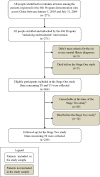Unlocking patients with mental disorders who were in restraints at home: a national follow-up study of China's new public mental health initiatives
- PMID: 25848800
- PMCID: PMC4388503
- DOI: 10.1371/journal.pone.0121425
Unlocking patients with mental disorders who were in restraints at home: a national follow-up study of China's new public mental health initiatives
Abstract
Background: In 2005, China implemented a demonstration program known as "686" to scale-up nation-wide basic mental health services designed to improve access to evidence-based care and to promote human rights for people with severe mental disorders. As part of the 686 Program, teams "unlocked" and provided continuous mental health care to people with severe mental disorders who were found in restraints and largely untreated in their family homes. We implemented a nation-wide two-stage follow-up study to measure the effectiveness and sustainability of the "unlocking and treatment" intervention and its impact on the well-being of patients' families.
Methods: 266 patients unlocked from 2005 in "686" demonstration sites across China were recruited in Stage One of the study in 2009. In 2012, 230 of the 266 cases were re-interviewed (the Stage Two study). Outcome measures included the patient medication adherence and social functioning, family burden ratings, and relocking rate. We utilized pre-post tests to analyze the changes over time following the unlocking efforts.
Results: 96% of patients were diagnosed with schizophrenia. Prior to unlocking, their total time locked ranged from two weeks to 28 years, with 32% having been locked multiple times. The number of persons regularly taking medicines increased from one person at the time of unlocking to 74% in 2009 and 76% in 2012. Pre-post tests showed sustained improvement in patient social functioning and significant reductions in family burden. Over 92% of patients remained free of restraints in 2012.
Conclusion: Practice-based evidence from our study suggests an important model for protecting the human rights of people with mental disorders and keeping them free of restraints can be achieved by providing accessible, community based mental health services with continuity of care. China's "686" Program can inform similar efforts in low-resource settings where community locking of patients is practiced.
Conflict of interest statement
Figures
References
Publication types
MeSH terms
Grants and funding
LinkOut - more resources
Full Text Sources
Other Literature Sources
Medical
Research Materials


